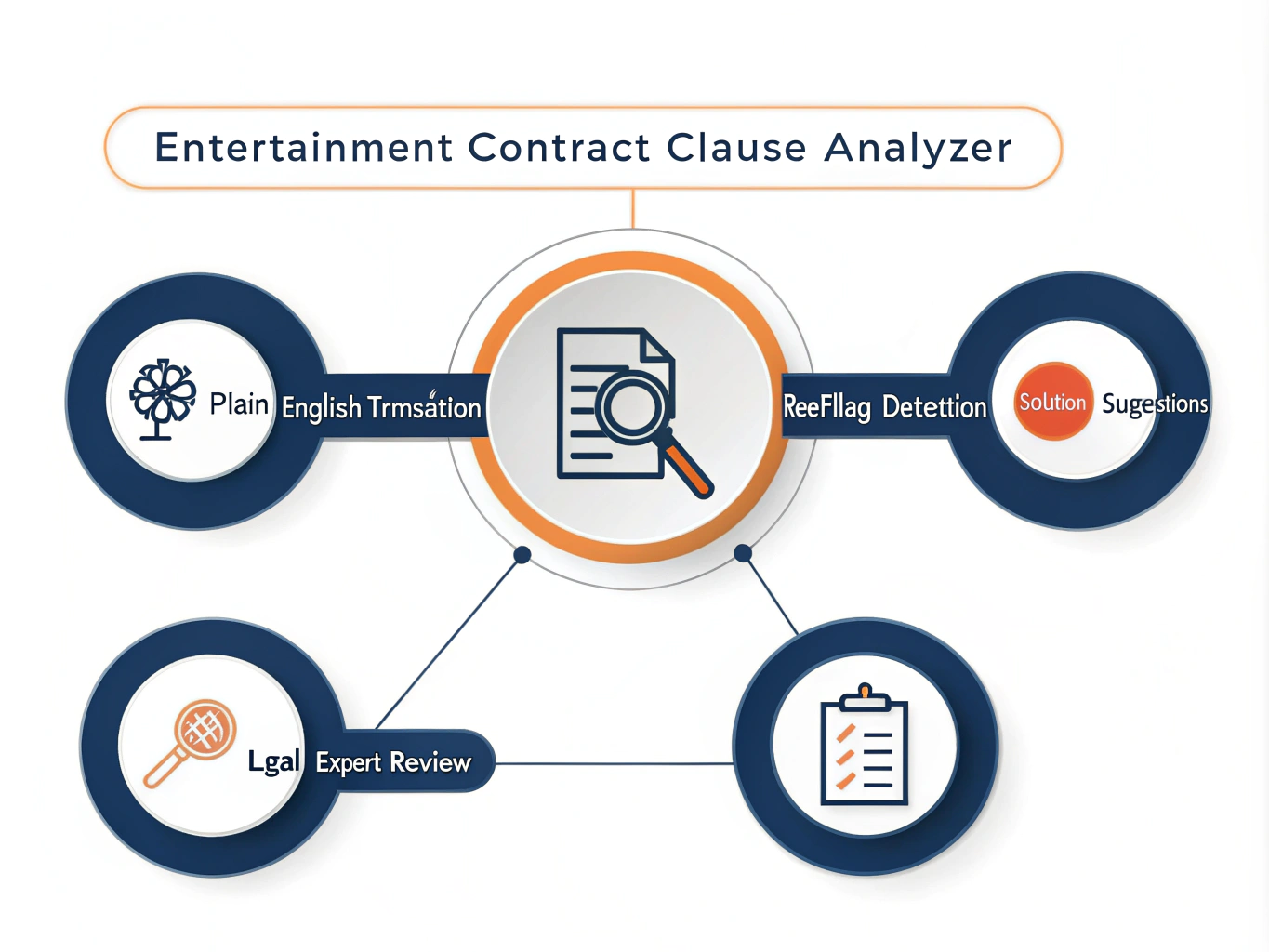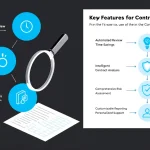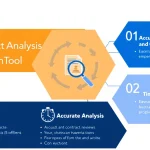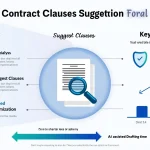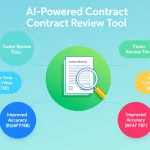Entertainment Contract Clause Analyzer
Is this tool helpful?
How to Use the Entertainment Contract Clause Analyzer Effectively
To make the most of our Entertainment Contract Clause Analyzer, follow these simple steps:
- Locate your contract clauses: Gather the entertainment contract clauses you want to analyze. These could be from a music recording agreement, film production contract, or any other creative industry agreement.
- Copy and paste the clauses: In the provided text area, paste the full text of the contract clauses you wish to analyze. For example, you might input:
- “Artist agrees to perform exclusively for Label for a period of five (5) years from the date of this agreement.”
- “All intellectual property created during the term of this agreement shall be the sole property of the Company.”
- Click “Analyze Contract Clauses”: Once you’ve entered your clauses, simply click the button to start the analysis process.
- Review the results: The tool will provide a comprehensive breakdown of each clause, including:
- A plain English interpretation
- Identified problem areas
- Suggested solutions or improvements
- Copy the analysis: Use the “Copy to Clipboard” button to easily save and share the results with your legal team or negotiating partners.
Empowering Creatives: Understanding Entertainment Contracts Made Easy
In the fast-paced world of entertainment, contracts are the backbone of professional relationships. However, the legal jargon often leaves artists and creatives feeling overwhelmed and vulnerable. Our Entertainment Contract Clause Analyzer is designed to bridge this gap, offering a powerful tool that demystifies complex legal language and empowers creatives to take control of their careers.
This innovative tool serves as a virtual legal assistant, breaking down intimidating contract clauses into easily digestible plain English. By providing clear interpretations, identifying potential pitfalls, and suggesting improvements, it equips artists, musicians, actors, and other creative professionals with the knowledge they need to make informed decisions about their careers and negotiate better terms.
The Power of Plain English in Entertainment Contracts
Entertainment contracts are notorious for their complex language and industry-specific terms. Our analyzer tackles this challenge head-on by translating legalese into clear, straightforward English. This transformation allows creatives to:
- Fully understand their contractual obligations
- Identify clauses that may be unfavorable or restrictive
- Recognize industry-standard terms and potentially unfair deviations
- Approach negotiations with confidence and clarity
Spotting Red Flags and Avoiding Pitfalls
One of the most valuable features of our Contract Clause Analyzer is its ability to highlight problematic areas within contract clauses. By identifying potential issues, it helps creatives avoid common pitfalls such as:
- Overly restrictive exclusivity clauses
- Unfair revenue sharing arrangements
- Excessive control over creative output
- Unreasonable contract durations
- Ambiguous termination clauses
By bringing these issues to light, the tool empowers artists to address concerns proactively, potentially saving them from years of unfavorable contract terms.
Tailored Solutions for a Better Deal
Beyond identifying problems, our analyzer goes a step further by suggesting solutions and improvements for each clause. These recommendations are based on industry best practices and aim to create a more balanced agreement. This feature is particularly valuable for:
- Emerging artists who may lack experienced legal representation
- Independent creators negotiating their own deals
- Established professionals looking to double-check their contracts
By providing actionable suggestions, the tool equips creatives with the knowledge to negotiate more effectively and secure better terms for their artistic endeavors.
The Benefits of Using the Entertainment Contract Clause Analyzer
1. Time and Cost Efficiency
Legal consultations can be expensive, especially for emerging artists or independent creators. Our Contract Clause Analyzer offers a cost-effective alternative, providing instant analysis without the need for lengthy and costly legal meetings. This efficiency allows creatives to:
- Quickly review multiple contract offers
- Prioritize which clauses need professional legal attention
- Make informed decisions on tight deadlines
2. Empowerment Through Knowledge
Knowledge is power, especially in contract negotiations. By demystifying legal language, our tool empowers creatives to:
- Engage in more meaningful discussions with industry professionals
- Ask pertinent questions during negotiations
- Advocate for their rights and interests more effectively
3. Improved Negotiation Outcomes
Armed with a clear understanding of contract terms and potential issues, artists and creatives are better positioned to negotiate favorable deals. This can lead to:
- More equitable revenue sharing arrangements
- Retention of crucial intellectual property rights
- Fairer terms for contract duration and exclusivity
- Clearer definitions of obligations and expectations
4. Risk Mitigation
By identifying problematic clauses early, creatives can avoid signing unfavorable contracts that could have long-lasting negative impacts on their careers. This proactive approach helps:
- Prevent costly legal disputes in the future
- Maintain creative freedom and career flexibility
- Protect long-term earning potential
5. Educational Value
Regular use of the Contract Clause Analyzer serves as an educational tool, helping creatives become more contract-savvy over time. This ongoing learning process:
- Builds confidence in handling business affairs
- Develops a better understanding of industry standards
- Enhances overall business acumen in the entertainment industry
Addressing User Needs: How the Analyzer Solves Specific Problems
Decoding Complex Legal Language
One of the primary challenges faced by artists and creatives is understanding the dense legal language in entertainment contracts. Our analyzer addresses this by providing clear, plain English interpretations of each clause. For example:
Original Clause: “The Artist hereby irrevocably assigns to the Company all right, title, and interest in and to any and all works created during the Term, including but not limited to all copyrights, trademarks, and other intellectual property rights therein.”
Plain English Interpretation: “You agree to give the company complete ownership of all work you create while under contract, including all copyrights and other related rights. This transfer of ownership is permanent and cannot be reversed.”
This translation allows artists to fully grasp the implications of what they’re agreeing to, enabling informed decision-making.
Identifying Unfair Terms
The analyzer is programmed to flag potentially unfair or unusually restrictive terms that may be hidden within standard-looking clauses. For instance:
Original Clause: “Artist agrees to render services exclusively for Label for a period of seven (7) album cycles or ten (10) years, whichever is longer.”
Analysis: “This clause imposes an unusually long exclusivity period. Standard industry contracts typically range from 3-5 album cycles or 5-7 years. The ‘whichever is longer’ provision could potentially extend the contract indefinitely if album releases are delayed.”
Suggested Improvement: “Negotiate for a shorter term, such as 3-5 album cycles with a maximum of 7 years. Consider adding clauses that allow for contract renegotiation or termination if certain milestones are not met.”
Clarifying Ambiguous Language
Contracts often contain vague or ambiguous language that can lead to misunderstandings or disputes. The analyzer helps by highlighting these areas and suggesting clearer alternatives. For example:
Original Clause: “Artist shall deliver commercially and technically satisfactory master recordings.”
Analysis: “This clause is problematic due to its vague language. The terms ‘commercially and technically satisfactory’ are not defined, which could lead to disputes over what constitutes an acceptable recording.”
Suggested Improvement: “Define specific technical standards for master recordings (e.g., minimum bit rate, file format). For commercial satisfaction, consider outlining a process for approval or revision, such as allowing for a set number of revisions or involving a neutral third party for assessment.”
Balancing Power Dynamics
Many entertainment contracts are initially drafted in favor of the company or label. The analyzer helps level the playing field by identifying clauses that disproportionately benefit one party and suggesting more balanced alternatives. For instance:
Original Clause: “Company shall have the right to recoup all advances and expenses from any and all revenue sources of Artist, including but not limited to record sales, publishing, merchandising, and touring income.”
Analysis: “This clause allows the company to recoup its investments from all of the artist’s income streams, which can significantly impact the artist’s ability to earn a living, especially in the early stages of their career.”
Suggested Improvement: “Negotiate for recoupment to be limited to specific revenue streams directly related to the company’s investment (e.g., record sales for a record deal). Consider caps on recoupment percentages from each stream to ensure you retain a portion of your income.”
Practical Applications: Real-World Scenarios
Scenario 1: Emerging Musician Signing First Record Deal
Sarah, an up-and-coming indie musician, receives her first record deal offer from a mid-sized label. Excited but cautious, she uses the Contract Clause Analyzer to review the agreement. The tool highlights several key issues:
- An unusually long contract term of 6 albums
- Broad rights grabs, including merchandising and publishing
- Vague language around marketing commitments
Armed with this information, Sarah consults a music attorney who helps her negotiate better terms, including:
- A reduced contract term of 3 albums with options for extension
- Retention of merchandising rights and a co-publishing deal
- Specific marketing budget commitments for each album release
The result is a more artist-friendly contract that protects Sarah’s long-term interests while still providing the label with the necessary rights to promote her work effectively.
Scenario 2: Actor Reviewing a Series Regular Contract
Michael, a television actor, is offered a series regular role on a new streaming platform show. He uses the Contract Clause Analyzer to review the lengthy agreement, which reveals:
- An exclusivity clause that prevents guest appearances on other shows
- Unclear language about compensation for streaming residuals
- Broad social media restrictions during and after the show’s run
With these insights, Michael and his agent focus their negotiations on:
- Modifying the exclusivity clause to allow for guest appearances during hiatus periods
- Clarifying and improving the residuals structure for various streaming metrics
- Narrowing social media restrictions to protect show secrets while allowing for personal brand building
The resulting contract provides Michael with more career flexibility and clearer compensation terms, while still meeting the production company’s needs.
Scenario 3: Author Reviewing a Book Publishing Deal
Elena, a first-time author, receives a publishing contract for her debut novel. Using the Contract Clause Analyzer, she identifies several areas of concern:
- A clause granting the publisher right of first refusal on her next two books
- Ambiguous language about the definition of “out of print” in the digital age
- Limited audit rights for royalty statements
With this information, Elena consults a literary agent who helps her negotiate:
- Limiting the right of first refusal to one book, with a specified time frame for the publisher’s decision
- Clearly defining “out of print” to include specific sales thresholds for both print and digital formats
- Expanded audit rights, including access to underlying sales data
These changes result in a contract that better protects Elena’s future works and ensures transparency in royalty reporting.
Frequently Asked Questions
1. Can this tool replace legal advice from an entertainment lawyer?
While our Contract Clause Analyzer is a powerful tool for understanding and identifying issues in entertainment contracts, it is not a substitute for personalized legal advice. We recommend using this tool as a first step to gain clarity and identify potential issues, but always consult with a qualified entertainment lawyer for final review and negotiation of important contracts.
2. How often should I use the Contract Clause Analyzer?
We recommend using the analyzer for every new contract you receive, as well as for any significant amendments to existing agreements. It’s also a good practice to periodically review your active contracts to ensure you’re fully aware of your ongoing obligations and rights.
3. What types of entertainment contracts can be analyzed with this tool?
Our analyzer is designed to handle a wide range of entertainment contracts, including but not limited to:
- Music recording and publishing agreements
- Film and television production contracts
- Book publishing deals
- Talent agency agreements
- Licensing and merchandising contracts
- Performance and appearance agreements
4. How does the tool stay updated with changes in entertainment law?
Our team of legal experts and data scientists regularly update the analyzer’s database to reflect changes in entertainment law, industry standards, and emerging contract trends. This ensures that the tool provides relevant and up-to-date analysis for users.
5. Can I use this tool for contracts in languages other than English?
Currently, our Contract Clause Analyzer is optimized for English-language contracts. However, we are working on expanding our language capabilities to serve a broader international audience in the future.
6. How does the analyzer handle industry-specific terminology?
The tool is equipped with an extensive database of industry-specific terms and their meanings across various entertainment sectors. It provides explanations for these terms in its plain English interpretations, ensuring that users can understand the full context and implications of each clause.
7. Can the tool help with negotiating better terms?
While the Contract Clause Analyzer doesn’t directly negotiate on your behalf, it provides valuable insights and suggestions that can inform your negotiation strategy. The tool’s analysis of problematic clauses and suggested improvements can serve as a starting point for discussions with the other party or your legal representative.
8. Is there a limit to the length of contract text I can analyze?
The tool is designed to handle contracts of various lengths, from short agreement clauses to comprehensive, multi-page documents. However, for optimal performance and accuracy, we recommend analyzing sections or clauses of the contract individually if you’re dealing with extremely lengthy agreements.
9. How can I ensure the confidentiality of my contract information?
We understand the sensitive nature of contract information. Our system is designed with strong security measures to protect your data. The tool processes the information you input without storing the full text of your contracts. However, for highly confidential agreements, we recommend using placeholder names or omitting specific identifying details when using the analyzer.
10. Can the tool help me understand royalty calculations and payment structures?
Yes, the Contract Clause Analyzer can help interpret complex royalty and payment clauses. It breaks down the calculation methods, identifies potential areas of concern (such as hidden deductions or unfavorable royalty rates), and suggests industry-standard alternatives where applicable.
Important Disclaimer
The calculations, results, and content provided by our tools are not guaranteed to be accurate, complete, or reliable. Users are responsible for verifying and interpreting the results. Our content and tools may contain errors, biases, or inconsistencies. We reserve the right to save inputs and outputs from our tools for the purposes of error debugging, bias identification, and performance improvement. External companies providing AI models used in our tools may also save and process data in accordance with their own policies. By using our tools, you consent to this data collection and processing. We reserve the right to limit the usage of our tools based on current usability factors. By using our tools, you acknowledge that you have read, understood, and agreed to this disclaimer. You accept the inherent risks and limitations associated with the use of our tools and services.
